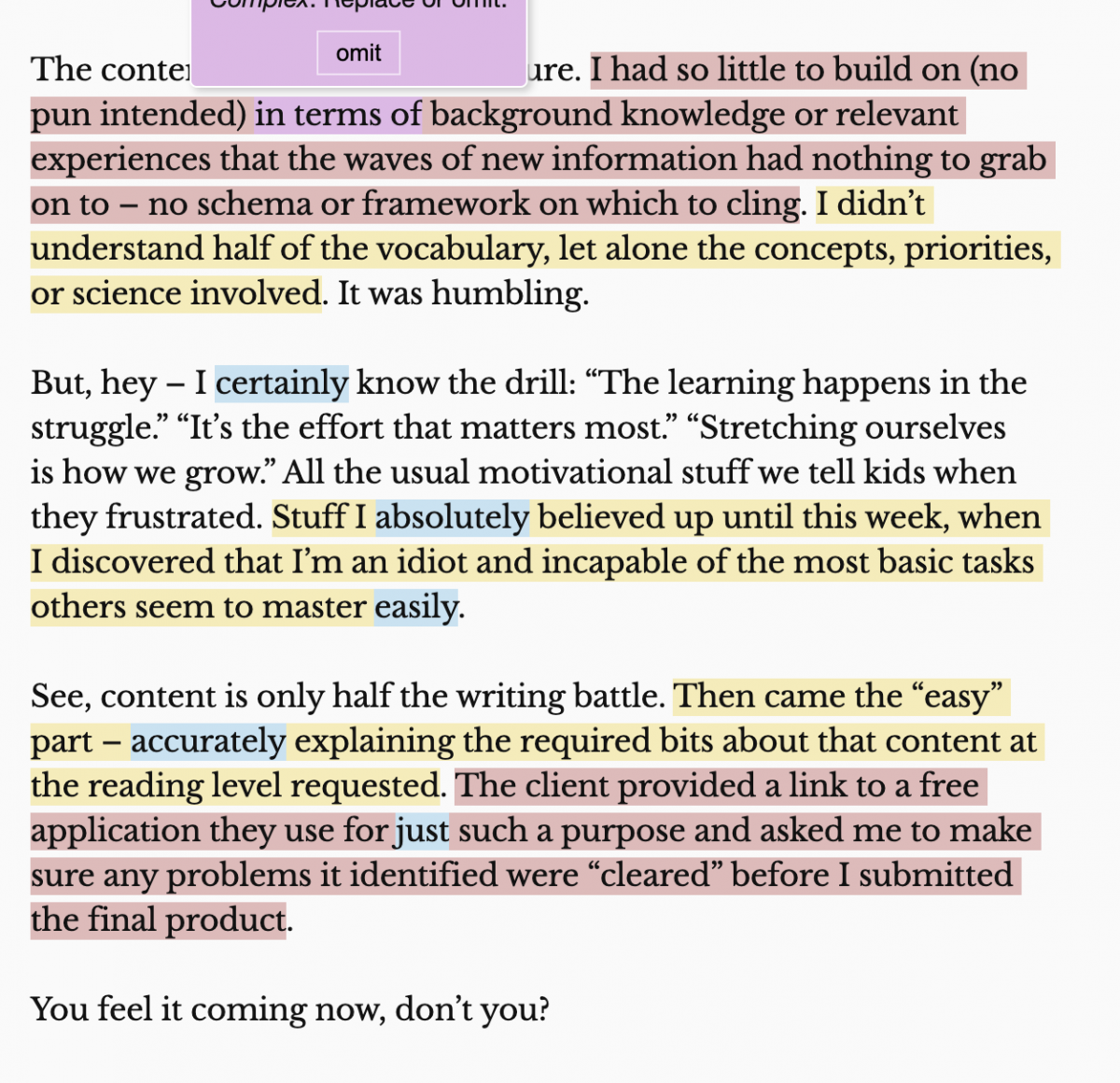 There’s a difference between caring how well you’re actually doing your job and caring how well you do on official evaluations. Ideally, the two at least overlap – like a Venn Diagram or pop and hip-hop. That’s not always a given, however. In practice, it’s often more like the relationship between reality and reality TV.
There’s a difference between caring how well you’re actually doing your job and caring how well you do on official evaluations. Ideally, the two at least overlap – like a Venn Diagram or pop and hip-hop. That’s not always a given, however. In practice, it’s often more like the relationship between reality and reality TV.
I know a teacher I’ll call Mr. Lutum. Mr. Lutum has been teaching forever – long enough that he began to fear he’d grown a bit stale. After some soul searching and a few months of crippling doubt and despair, he decided that if he were going to continue teaching, he at least needed a fresh start and a serious change of scenery.
He took a position in a high poverty, majority-minority district in the building people only work at until they have enough seniority to go elsewhere. Lutum figured he’d put his lofty rhetoric and progressive ideals to the test and see if he actually had the chops to work with kids who are nothing like himself – hopefully without becoming either cynical or patronizing. It was around this time I met Mr. Lutum at a local workshop and we began staying in touch – first just talking teacher talk, and eventually carrying on about other things.
We’re both in northern Indiana, and both of us moved here from other states. One thing we’d noticed is that in ultra-conservative states, the official solution to almost any problem is “punish them more.” If that doesn’t work, “punish them harder” or “punish those around them” pretty much exhausts the limits of legislative imaginations. None of that restorative-nurturing-touchy-feely nonsense here! All problems are nails – poverty, mental health, crime, poor schools, crumbling infrastructure, general malaise and despair. Fortunately, the state has a big hammer and uses it regularly and gleefully.
In their defense, they genuinely believe this demonstrates their concern over social ills and the like. It’s WJWD.
Local governments – right down to school boards and building administrators – have learned that, as middlemen of sorts, they have two basic options. They can become hammers themselves… or end up nails. The practical result of this is that in the local public schools, “accountability” and “high standards” have little to do with figuring out what works, and much to do with demonstrating that bent nails will not be tolerated. (Or straightened.)
The community is poor, families are broken, the economy is a mess, and relationships between parents and schools, citizens and police, business and society, are largely dysfunctional and periodically hostile. The state is criticized for not doing more to help local schools, who are in turn criticized for not doing more to revolutionize the lives and circumstances of each and every child within their boundaries via grammar worksheets and basic math skills. By way of showing their true commitment to educational progress, the schools shut down for standardized testing nearly every month for at least a few days.
In their defense, most schools are reacting to state mandates, threats, and demands. Because there are so many things they can’t control – home lives, poverty, culture, lack of interest, a global pandemic – they’ve doubled down on the things they can, which brings us to one of their favorite categories of nails – teachers in low-performing districts. “It’s time to accountability you with some high expectations, beehatch. It would take forever to get to know you and your classrooms, explore the dynamics of your interactions with kids or the systemic challenges you face which prevent you from accomplishing more. What we can do, however, is mandate this pretty impressive rubric to judge your classroom performance based on a 30-minute observation by someone desperate to stay a hammer twice a year.”
 Teacher evaluation rubrics usually involve detailed sub-categories cascading for pages under ranking columns with names like “Excellent,” “Adequate,” “Could Be Better,” “My God You Suck,” and “Not Observed.” These are laid out in a giant spreadsheet or in an iPad app with descriptions of where a teacher might land on each measured characteristic.
Teacher evaluation rubrics usually involve detailed sub-categories cascading for pages under ranking columns with names like “Excellent,” “Adequate,” “Could Be Better,” “My God You Suck,” and “Not Observed.” These are laid out in a giant spreadsheet or in an iPad app with descriptions of where a teacher might land on each measured characteristic.
For example, “Lesson Organization”:
EXCELLENT: Lesson is clearly laid out with pre-teaching or connection to previously learned materials, new content or skills, and formative or informative assessment to determine the extent to which students have mastered the new material. Instructor demonstrates effective differentiation and connects content and skills to students’ lives, learning styles, and future endeavors in meaningful ways throughout the lesson. Teacher has clear plans for students who excel quickly, who understand adequately, who struggle with the material, or who remain unaware or detached and implements each of these strategies with the appropriate students simultaneously.
ADEQUATE: Randomly insert the word “somewhat” into previous description so the distinction sounds quantitatively meaningful.
COULD BE BETTER: Replace “somewhat” with “rarely” but nod severely as you do to demonstrate thoughtful concern.
MY GOD YOU SUCK: Teacher is moderately conscious and may or may not have traces of drool working its way dramatically down their chin. There is little or no pre-teaching or connection to prior learning and teacher doesn’t appear to know students’ names, personal histories, family stories, emotional issues. Plus, I’d swear there were at least two kids playing on their phones which she totally ignored! Remediation consists primarily of discouraged sighs and instructions to “look, just give me something, OK?” before teacher crawls under desk and weeps in despair.
 Here’s the other thing: it doesn’t matter if there’s a pandemic or if every teacher in the building is a Mr. Miyagi, Dewey Finn, or John Keating. “High expectations” means a percentage of them have to be scored harshly because “high expectations.” It’s like a college course being graded on a curve and there were going to be 3 ‘A’s, 10 ‘B’s, 12 ‘C’s, 10 ‘D’s, and 3 ‘F’s no matter how well or poorly individuals might actually do. Oh, and your grade for the entire course is based solely on page 3 of one of the 12 essays you’re required to do that semester.
Here’s the other thing: it doesn’t matter if there’s a pandemic or if every teacher in the building is a Mr. Miyagi, Dewey Finn, or John Keating. “High expectations” means a percentage of them have to be scored harshly because “high expectations.” It’s like a college course being graded on a curve and there were going to be 3 ‘A’s, 10 ‘B’s, 12 ‘C’s, 10 ‘D’s, and 3 ‘F’s no matter how well or poorly individuals might actually do. Oh, and your grade for the entire course is based solely on page 3 of one of the 12 essays you’re required to do that semester.
Last year was Lutum’s first year at this particular school, and – as was somewhat expected – the learning curve was steep. It’s one thing to know the culture and dynamics of a building are quite different than what you’ve experienced before and another to manage those dynamics effectively. As the latest newcomer, he was an unknown quantity and thus had zero credibility in the eyes of most students. He was regularly challenged both directly and indirectly and had to up his game a bit with classroom management and personal interactions. Then came time for formal administrator observations and his first evaluation.
“I normally don’t care about that kind of thing,” he told me. “I’ve always believed that if I’m doing what I think is best for my kids, things like state tests or administrative paperwork either take care of themselves or simply have to be endured. I was a little uncomfortable this time, however, partly because I knew things weren’t going all that well in class, but also because my supervising administrator had shown little interest in getting to know me (or any of the other teachers) beyond periodically walking the halls to make sure we were on duty during passing periods and that our doors were locked during class.”
Lutum was scheduled to be observed during his 2nd period – a class of about 25 freshmen. Halfway through 1st period, an announcement came over the intercom to dismiss all band students for dress rehearsal in preparation to some contest they were attending that weekend. That meant that the 8 – 9 students most likely to participate (or to even know what was going on) were leaving. Normally, Lutum would have changed what he did in class that day to reflect the change of circumstances – try to keep it meaningful for those who remained – but the evaluation rubric doesn’t have a category for “what’s best for the kids actually present.” He’d have to plow ahead and get those boxes checked, students be damned.
 It didn’t go well. He was marked down for things like insufficient connections to prior knowledge – despite the evaluating administrator arriving 10 minutes after the lesson started and the kids not actually having much in the way of applicable prior knowledge. Two kids were doing other things on their iPads which he couldn’t see but the administrator could, meaning he lacked “awareness.” Other than that, it was lots of blank stares and hostile body language. (Also, the kids didn’t seem that glad to be there either.)
It didn’t go well. He was marked down for things like insufficient connections to prior knowledge – despite the evaluating administrator arriving 10 minutes after the lesson started and the kids not actually having much in the way of applicable prior knowledge. Two kids were doing other things on their iPads which he couldn’t see but the administrator could, meaning he lacked “awareness.” Other than that, it was lots of blank stares and hostile body language. (Also, the kids didn’t seem that glad to be there either.)
He spent the next few weeks trying to assemble documentation to get him up to a score that prevented a required “plan of improvement” and vowed to do better in the Spring, knowing he’d not see or hear from his administrator before it was time to schedule the next evaluation.
Then the pandemic hit.
Evaluations last fall were based on his Canvas page, and again he was slammed for things like insufficient differentiation – meaning, I guess, that his prerecorded online lessons didn’t adapt throughout each period to the individual needs and responses of the students who weren’t doing them. He asked his evaluating administrator about this and he was at least sympathetic. “Hey, look – I have to be able to document it to give you ‘Adequate’, and I’m not seeing it. If you can show me something that qualifies, I’d love to change it.
Again he spent a few weeks trying to nudge the score up past “please don’t fire me” and began wondering why he gave up the easy gig in Michigan where everybody loved him and he had tenure.
Since Spring Break, Lutum has had 8 – 10 in person students each period (while still expected to keep up with virtual learning for the rest.) Last week was the first time this year he was scheduled to be observed in person. He made sure there were no extra band rehearsals or major sporting events scheduled and spent the two weeks beforehand trying to establish some classroom dynamics as students began wandering randomly back from virtual learning to in person school. He chose the period right before lunch when students were awake enough to participate but weren’t as hyper as they got after whatever fights broke out at lunch.
A few days beforehand, his evaluator emailed that he couldn’t make it that hour – could they do 1st period? Not wanting to seem insecure or unprepared, Lutum agreed.
 The day before the visit, the building principal came on the intercom and announced that tardies were out of control and that teachers were to lock their doors when the bell rang – no exceptions. Those students would report to detention for the rest of the period. (1st period, unsurprisingly, has more tardies than any other hour.) That announcement was followed by a list of all the busses running late that day. There were always at least 3 – 4; that day Mr. Lutum estimates it was more like 7.
The day before the visit, the building principal came on the intercom and announced that tardies were out of control and that teachers were to lock their doors when the bell rang – no exceptions. Those students would report to detention for the rest of the period. (1st period, unsurprisingly, has more tardies than any other hour.) That announcement was followed by a list of all the busses running late that day. There were always at least 3 – 4; that day Mr. Lutum estimates it was more like 7.
It had been a few weeks since they’d covered “irony” in class, but maybe that should have been the lesson he’d prepared for observations. Once again, he wasn’t going to have enough students to demonstrate anything on the checklist. Well, maybe Brittney. She’s always there early. Nice kid. Clueless, of course, but enthusiastic. Yeah, allusions and metaphors will go great with just her. The breakout groups activity would be particularly impressive, and her first chance to be group leader. Of herself.
He could have tried to reschedule, but why? Hammers need nails. They have no use for screws, widgets, duct tape, or clamps. At some point the nail has to either stop trying to pull away and accept its fate or figure out how to become a hammer – something Mr. Lutum was unwilling to do.
“Bring it on,” he told me. “I figure no one else is lined up begging for this job. Let’s get the part over with so I can get back to trying to figure out how to help the kids actually in front of me, and if they want to start a paperwork trail to fire me, so be it.”
I guess a single nail sticking up does look a bit like a middle finger. And I’m OK with that.
Postscript: It went fine. Ludum had 5 kids show up and found out later when they saw an administrator in the room most had assumed they were in trouble of some sort. They didn’t have great answers but they upped their game considerably and tried to look attentive (and not like nails). He’d forgotten to tell them what was happening that day and had no idea they’d be panicked by a principal visit. Turns out he’s still learning a few things about his new school.

RELATED POST: Teacher Tired
RELATED POST: 5 Bad Assumptions Behind ‘Education Reform’
RELATED POST: RetainingBaby Teachers (A Tale Of Ms. Hope)

 We’ve been reading up on Supreme Court cases involving “student rights” in one of my classes. Most of the readings and videos have involved the biggies – student speech, mostly, and some search and seizure. I recently asked them to pick a topic related to student rights in school, and of course offered a list of possibilities for those not particularly motivated to come up with their own.
We’ve been reading up on Supreme Court cases involving “student rights” in one of my classes. Most of the readings and videos have involved the biggies – student speech, mostly, and some search and seizure. I recently asked them to pick a topic related to student rights in school, and of course offered a list of possibilities for those not particularly motivated to come up with their own.  Several years ago, my wife and I moved from Oklahoma to northern Indiana. We’re still surrounded by radical right-wingers, but compared to Oklahoma, this might as well be an anarcho-syndicalist commune. Still, there are things about Oklahoma I miss (other than friends and family, of course).
Several years ago, my wife and I moved from Oklahoma to northern Indiana. We’re still surrounded by radical right-wingers, but compared to Oklahoma, this might as well be an anarcho-syndicalist commune. Still, there are things about Oklahoma I miss (other than friends and family, of course). Like many people, I’ve been trying my hand at freelancing here and there for extra income over the past few years. In my case, it’s nothing glorious – just writing (or rewriting) web content explaining the benefits of regular eye exams, how a reverse mortgage works, or where Eddie Murphy’s net worth ranks him compared to other actors or comics. (He’s doing better than Mike Myers or Denzel Washington but not as well as Rowan Atkinson or Robert Downey, Jr.)
Like many people, I’ve been trying my hand at freelancing here and there for extra income over the past few years. In my case, it’s nothing glorious – just writing (or rewriting) web content explaining the benefits of regular eye exams, how a reverse mortgage works, or where Eddie Murphy’s net worth ranks him compared to other actors or comics. (He’s doing better than Mike Myers or Denzel Washington but not as well as Rowan Atkinson or Robert Downey, Jr.) The content was difficult, to be sure. I had so little to build on (no pun intended) in terms of background knowledge or relevant experiences that the waves of new information had nothing to grab on to – no schema or framework on which to cling. I didn’t understand half of the vocabulary, let alone the concepts, priorities, or science involved. It was humbling.
The content was difficult, to be sure. I had so little to build on (no pun intended) in terms of background knowledge or relevant experiences that the waves of new information had nothing to grab on to – no schema or framework on which to cling. I didn’t understand half of the vocabulary, let alone the concepts, priorities, or science involved. It was humbling. I did my first draft in Microsoft Word like I always do. It’s silly, but I have specific fonts and margins that feel right to me and help me think more clearly. My preferred approach is to just get it all down on paper (well, virtual paper) then go back and clean it up afterward. I’m usually well over maximum word count with my first drafts, but I’ve accepted this as my own personal style – which is a nice way to say it’s a glaring flaw I’ve simply learned to work through each and every time.
I did my first draft in Microsoft Word like I always do. It’s silly, but I have specific fonts and margins that feel right to me and help me think more clearly. My preferred approach is to just get it all down on paper (well, virtual paper) then go back and clean it up afterward. I’m usually well over maximum word count with my first drafts, but I’ve accepted this as my own personal style – which is a nice way to say it’s a glaring flaw I’ve simply learned to work through each and every time. Please understand, my Eleven Faithful Followers – this story isn’t about the app. It’s not about whether or not the writing was as bad as it looked or the reading level of the target audience for this particular company. I’m a grown-up (well, most of the time). I was hired to do a job a certain way and if I can’t do it the way they want, I don’t deserve to get paid. My opinions about rhetorical choices are irrelevant in this situation.
Please understand, my Eleven Faithful Followers – this story isn’t about the app. It’s not about whether or not the writing was as bad as it looked or the reading level of the target audience for this particular company. I’m a grown-up (well, most of the time). I was hired to do a job a certain way and if I can’t do it the way they want, I don’t deserve to get paid. My opinions about rhetorical choices are irrelevant in this situation. Like many of you, I’ve learned over the years to let it out without doing anything too destructive and then come back and deal with whatever set me off. That’s the advantage of age and a little wisdom. It’s not about avoiding every possible failure; it’s about how we recover and respond, yada yada growth mindset, mutter mumble faster smarter wiser, blah blah blah cue Captain Marvel soundtrack.
Like many of you, I’ve learned over the years to let it out without doing anything too destructive and then come back and deal with whatever set me off. That’s the advantage of age and a little wisdom. It’s not about avoiding every possible failure; it’s about how we recover and respond, yada yada growth mindset, mutter mumble faster smarter wiser, blah blah blah cue Captain Marvel soundtrack. At the risk of sounding preachy about something I’m certain we all already know, let’s remember this coming year to be intentional and aware when it comes to standards and expectations and how we convey them. Don’t sacrifice your belief that students can and should do better just because it’s been a weird couple of years. Academics matter. Progress matters. Sometimes pushing them is for their own good. Sometimes they need to fail (short-term) to grow.
At the risk of sounding preachy about something I’m certain we all already know, let’s remember this coming year to be intentional and aware when it comes to standards and expectations and how we convey them. Don’t sacrifice your belief that students can and should do better just because it’s been a weird couple of years. Academics matter. Progress matters. Sometimes pushing them is for their own good. Sometimes they need to fail (short-term) to grow.